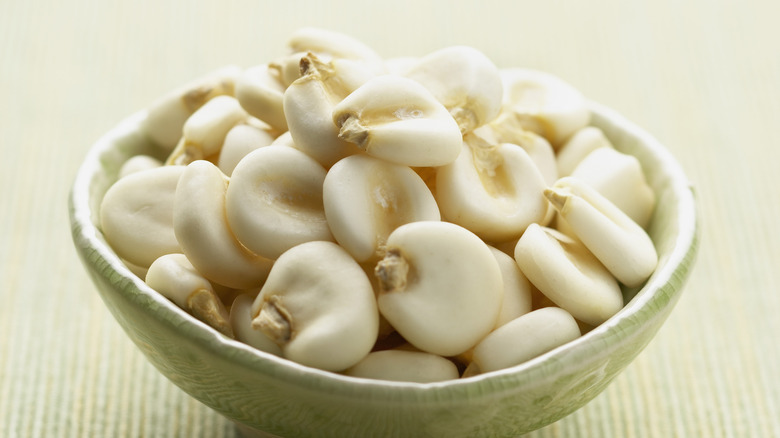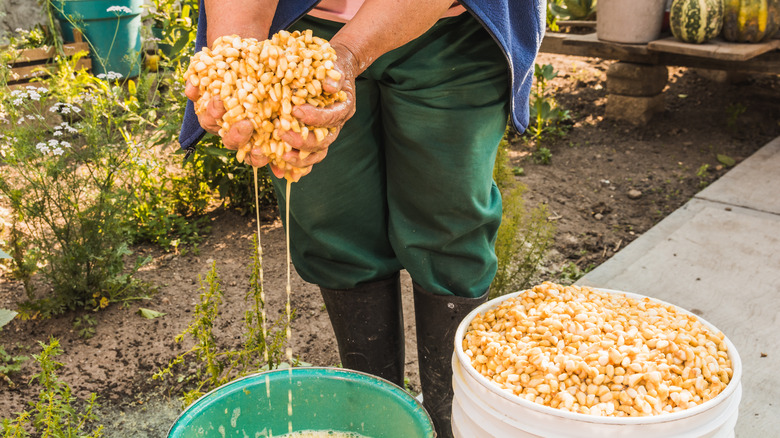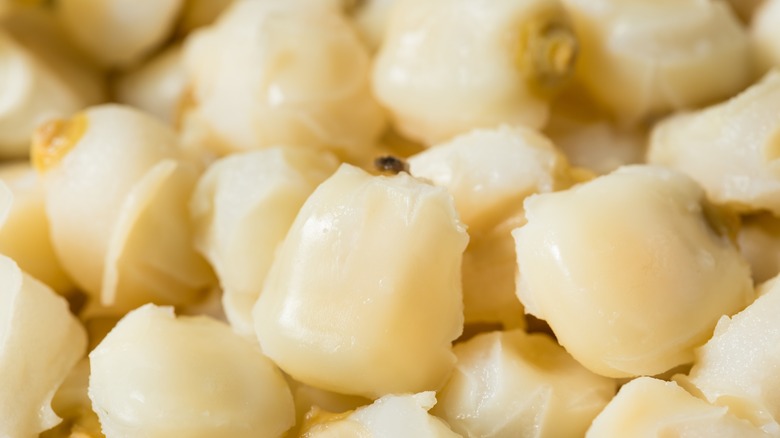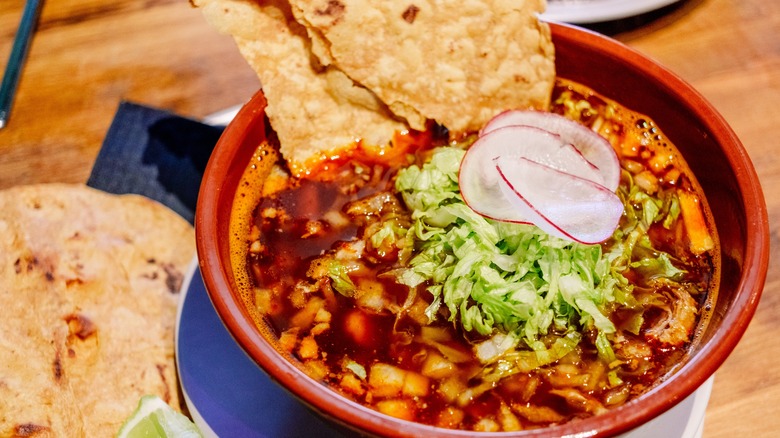Is Hominy The Same Thing As Corn?
Corn is a staple food throughout the world, and this sweet starch takes on many diverse forms. It's the base of cornflakes in our breakfast cereal, the main ingredient for making tortillas, and popped to make our favorite cinema snack. It also shows up in dishes like grits and pozole — but in these dishes, corn is referred to as hominy. Why?
All hominy is corn, but not all corn is hominy. There is not a special variety of corn called hominy; it normally comes from the simple field corn, the classic yellow or white corn with large cobs. The process of turning corn into hominy is called nixtamalization. It starts with whole, dried corn kernels that are then soaked in an alkaline mixture that softens the tough outer shell of the corn kernel. The most common alkaline mixture is lime added to water; not to be confused with the fruit, lime is also called calcium hydroxide and is derived from processed limestone rock. Before commercially available lime, wood ash was used to soak and soften corn kernels, which is sometimes still used in Mexico.
Once corn is nixtamalized, it is called nixtamal, which is what we know as hominy in English. It is labeled with the name hominy when it is sold in a can, dried as whole kernels, or coarsely ground for grits. Nixtamal can be ground into masa, an incredibly important component in Mexican cuisine used to make foods like tortillas and tamales.
Nutrition profile of hominy
The nixtamalization process transforms the nutrition profile of corn. By softening and removing the pericarp of the corn kernel, the fibrous outside hull, the protein found in corn becomes more available. It allows essential amino acids present, like lysine and tryptophan, to become easier to digest and absorb. The availability of niacin (vitamin B3), required for protein synthesis and converting food into energy, and calcium, is also increased. Although hominy and corn come from the same plant, hominy is considered to be nutritionally superior.
The nixtamalization process was first used by the Aztecs and Mayans in Mesoamerica. It was likely developed to break down tough corn kernels to make tastier, softer, and more pliable tortillas. However, it also allowed the ancient civilizations of Mesoamerica to have a more nutritious diet, and increase the protein content of their staple food. It eliminated the consumption of mycotoxins, which can be present in raw corn; these toxins would have been harmful or deadly to their health.
The taste and texture of hominy
The processing of corn to make it hominy changes both the texture and flavor. From the can or cooked from a dried kernel, hominy has a somewhat bland flavor — it has a starchy sweetness like corn but more mild. It's a bit nutty and earthy, and when cooked, it has a flavor that is reminiscent of tortilla chips. Overall, it has a neutral flavor that works well for absorbing other spices and flavors in a dish. The big, soft kernels are easy to chew and almost have a meaty texture.
The corn we best known in the United States is field corn or sweet corn, but in Mexico, there are many native varieties with unique flavors. There are considered to be five types of corn divided by the type of kernel, but over 900 varieties that range in color, size, and flavor exist. Each can have a different taste, ranging from sweet to earthy. Hominy typically only comes from one type of corn; it lacks diversity in flavor. However, in Mexico, different varieties of heirloom corn are nixtamalized to make masa, so this is where you will find the diversity of flavors in hominy or nixtamal.
Fresh corn kernels have a juicy crunch when you bite into them; even when corn is canned or frozen and cooked correctly, it can maintain this texture. After nixtamalization, hominy loses the juicy crunch, and it only gets softer once it is canned or cooked.
Cooking with hominy
The most well-known dish where hominy has the spotlight is pozole, a flavorful Mexican soup made with pork, chiles, and fresh toppings like radish, crema, lime, and shredded lettuce. The soft, chewy texture of hominy in a soup dish is similar to adding another starch like rice or pasta, plus it soaks of the spice and flavor of the broth. It's a great addition to chilis and stews, and can provide a meaty texture in vegetarian soups.
Outside of Mexican cuisine, hominy stars in a classic Southern dish called grits. This simple dish is made from a base of dried and coarsely ground hominy that is then soaked in salted water or milk to create a breakfast porridge. It is most frequently eaten as a breakfast food with sweet toppings, but it can easily be made savory with ingredients like cheese, greens, and shrimp. It's easy to confuse polenta and grits because these foods have a similar texture — but polenta is made from yellow corn that has not been nixtamalized.
Hominy can be used in place of other starches, like replacing potato in au gratin or even as a gluten-free substitute for pasta in mac and cheese. The texture works well as a topping for fresh salads and vegetable-forward dishes, or as an addition to a warm casserole.



